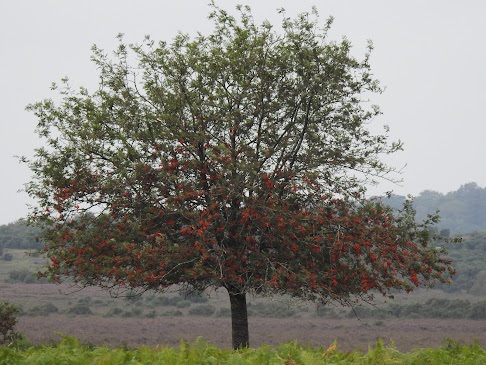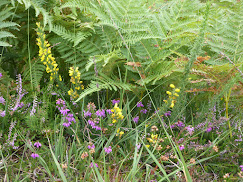A
lovely misty morning among the great oaks, Beeches and conifers though it
wasn’t long before the sun burst through the canopy.
We
started with a glimpse of a Great Spotted Woodpecker and heard Robin, Coal Tit
and Jay in the trees around us. The grassy rides were carpeted in delicate dew
covered cobwebs, each with a small spider at its centre.
A few
butterflies, Red Admiral and Speckled Wood, emerged to dance in the pools of
sunlight before we deviated briefly into a clearing in search of slime moulds.
We found just old remains of a yellow Dog’s Vomit Slime Mould but came across a
good display of a coral fungus, .Ramaria stricta
 |
| Ramaria stricta © Richard Smith |
We
found another good fungal specimen at the base of a beech tree, Cauliflower
Fungus, and several Violet Door Beetles before we emerged from the wood and
followed the wood margin up the hill.
 |
| Cauliflower Fungus © Richard Smith |
A damp
drainage ditch encouraged dragonfly, moss and sundew and several Southern Wood
Ant mounds were dotted up the line. Looking
out across the Gorse and heather a distant raptor was probably a large female Sparrowhawk being mobbed by crows, for generally Corvids avoid Goshawks like the plague. Much nearer was a family of
Stonechat. An
attractive moth, a Silver Y, settled on the bracken by the path and we found
Oyster Mushrooms, King Alfreds Cakes, and heard Nuthatch and Long-tailed Tits.
Diving
back into the wood we headed back, finding Green Elf Cup, several Russula
mushrooms, an immature Beefsteak Fungus that resembled a slime mould, heard Ravens
croaking nearby and saw a fascinating collection of more Violet Door Beetles
working through a patch of dung.
 |
| Green Elf Cup © Chris Robinson |
 |
| Fox poo with Sloe stones and Violet Dor Beetles © Chris Robinson |
 |
| An immature Beefsteak Fungus © Andy Skarstein |
Back in
the car park a wonderful specimen of a Goat Moth caterpillar was found. I hope
everyone enjoyed a lovely morning in the woods despite not finding many birds
and, in particular, the promised array of exotic species such as Crossbill and
Dartford Warbler. Glad I didn’t mention the Wildebeest! RP
 |
| Goat Moth caterpillar © Andy
Skarstein |

























